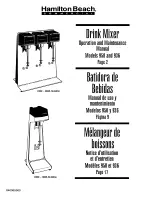
18
5. OPERATION
The Behringer FEEDBACK DESTROYER can operate in four different modes. To meet more complex re-
quirements with regard to flexible signal processing, these modes can be combined in a program.
5.1 Activating/deactivating the filters
In
Off mode, the corresponding filter is deactivated and can be activated by selecting one of the modes
described below.
5.2 Manual filters / parametric equalizer
The FEEDBACK DESTROYER allows you to freely process any music signals. To raise or lower specific
frequencies in level, you can directly select these frequencies by means of the manual filters (
Parametric
EQ mode). Each filter has the functionality of a fully parametric EQ, i.e. you can set the center frequency, the
quality factor (Q) and the amount of boost/cut (in dB).
5.3 Automatic filters
The FEEDBACK DESTROYERs automatic filters operate in two modes:
Single-Shot and Auto mode. In
order to find a feedback, the FEEDBACK DESTROYER divides the entire frequency band into 1/60 octave
steps (20 Hz to 20 kHz) and determines the respective level of these individual bands. He compares this
value to the level of the entire signal. The difference of these levels determines whether a filter is set. The
FEEDBACK DESTROYER now provides you with the unique possibility to adapt this parameter according to
your own needs. You can edit this feedback sensitivity (see 5.4.2) within a range of -3 dB to -9 dB (in 1 dB
steps). The standard value for this parameter is -6 dB. This value provides an optimal recognition of feedback
during most applications. During e.g. a pure speech transmission, the feedback sensitivity can be lowered to
-9 dB. In this way, the algorithm would recognize and would suppress a feedback even faster. On the other
hand a higher adjustment of the feedback sensitivity (e.g. -3 dB) makes feedback suppression more stable.
In addition to that intended feedbacks (guitars or keyboards) become recognized much more slower.
Filters in Single-Shot mode automatically analyze the music signal to detect feedback frequencies. Having
detected such a frequency, the filter automatically configures its parameter to suppress feedback as effi-
ciently as possible. As the filter is locked to the detected frequency, this mode is ideally suited to suppress
feedback having a constant frequency. Possible applications are “fixed-position” microphones (e.g. on the
drums). After the filter has adjusted itself automatically, it enters a special Lock mode, which means that
although the frequency remains fixed, the width and depth of the filter are still being adapted to the feedback
frequency, i.e. the width is increased as soon as the feedback frequency begins to shift, and the gain is cut if
feedback prevails. The gain is not reduced to prevent feedback from recurring.
All microphones that are moved during a performance (e.g. vocal mics) very often have varying feedback
frequencies. This type of feedback should be suppressed in Auto mode. As in Single-Shot mode, the filter
automatically selects an ideal setting for feedback suppression. But in Auto mode a locked filter tracks and
suppresses the feedback frequency even as it changes. The optimum frequency is selected automatically
and the filter is set to narrow-band mode so as to influence the music signal as little as possible. If your music
contains wanted feedback elements (e.g. guitar feedback), it is highly probable that these will be suppressed
too in Auto mode, because from a physical point of view it is impossible to distinguish “wanted” from “un-
wanted” feedback. Please read the hints given in section 6.3 to work around this situation.
5.4 Working with programs
In order to store your favorite settings, the FEEDBACK DESTROYER has ten user presets and a default
preset. All operating parameters can be stored, i.e. your programs are recalled in full detail. Of course, all
settings will be retained even after switching the FEEDBACK DESTROYER off. Owing to state-of-the-art
circuitry, no internal battery is needed, hence the memory contents will not be lost. In the default preset
(display “--”), which serves as a basis for creating your own programs, all filters remain in the parametric
mode, with bandwidth set to 1 octave, a frequency of 500 Hz and 0 dB gain.
5. OPERATION















































